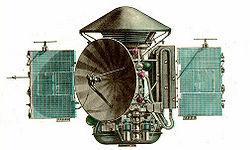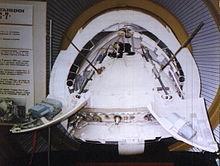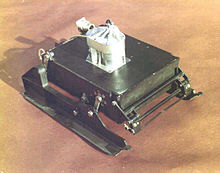- Mars 2
-
Mars 2 
Mars 2 OrbiterOperator USSR Mission type Orbiter and lander Orbital insertion date November 27, 1971 Orbits 362 Launch date 1971-05-19 at 16:22:44 UTC Launch vehicle Proton K with Blok D Mission duration 22 August 1972 COSPAR ID 1971-045A Mass 2,265 kg (4,990 lb) Orbital elements Eccentricity .71178 Inclination 48.9° Apoapsis 24,940 km (15,500 mi) Periapsis 1,380 km (860 mi) Orbital period 17.96 h The Mars program was a series of Mars unmanned landers and orbiters launched by the Soviet Union in the early 1970s.
The Mars 2 and Mars 3 missions consisted of identical spacecraft, each with an orbiter and an attached lander; they were the first human artifacts to impact the surface of Mars. They were launched by Proton K heavy launch vehicle with a Block D upper stage.
- Launch Date/Time:
- Mars 2: 1971-05-19 at 16:22:44 UTC
- Launch mass (including fuel):
- Combined: 4,650 kg (10,300 lb)
- Orbiter: 3,440 kg (7,600 lb)
- Lander: 1,210 kg (2,700 lb)
- On-orbit dry mass: 2,265 kg (4,990 lb)
- Dimensions: 4.1 m (13.5 ft) tall, 2 m (6.6 ft) across (5.9 m (19.4 ft) across with solar panels deployed)
Contents
Orbiter
The orbiter engine performed a burn to put the spacecraft into a 1380 x 24,940 km, 18 hour orbit about Mars with an inclination of 48.9 degrees. Scientific instruments were generally turned on for about 30 minutes near periapsis
The orbiter primary scientific objectives were to image the Martian surface and clouds, determine the temperature on Mars, study the topography, composition and physical properties of the surface, measure properties of the atmosphere, monitor the solar wind and the interplanetary and Martian magnetic fields, and act as communications relays to send signals from the landers to Earth.
The Mars 2 orbiter sent back a large volume of data covering the period from December 1971 to March 1972, although transmissions continued through August. It was announced that Mars 2 had completed their mission by 22 August 1972, after 362 orbits. The probe, combined with Mars 3, sent back a total of 60 pictures. The images and data revealed mountains as high as 22 km, atomic hydrogen and oxygen in the upper atmosphere, surface temperatures ranging from -110 °C to +13 °C, surface pressures of 5.5 to 6 mbar (0.55 to 0.6 kPa), water vapor concentrations 5000 times less than in Earth's atmosphere, the base of the ionosphere starting at 80 to 110 km altitude, and grains from dust storms as high as 7 km in the atmosphere. The images and data enabled creation of surface relief maps, and gave information on Martian gravity and magnetic fields.
Lander
Mars 2 Lander 
Mars 2 Lander model at the Memorial Museum of Cosmonautics in RussiaOperator USSR Mission type Lander COSPAR ID 1971-045F Mass 358 kg The lander crashed on the Martian surface and was lost.
The Mars 2 descent module was mounted on the bus/orbiter opposite the propulsion system. It consisted of a spherical 1.2 m diameter landing capsule, a 2.9 m diameter conical aerodynamic braking shield, a parachute system and retro-rockets.
The entire descent module had a fueled mass of 1210 kg, the spherical landing capsule accounting for 358 kg of this. An automatic control system consisting of gas micro-engines and pressurized nitrogen containers provided attitude control. Four "gunpowder" engines were mounted to the outer edge of the cone to control pitch and yaw.
The main and auxiliary parachutes, the engine to initiate the landing, and the radar altimeter were mounted on the top section of the lander. Foam was used to absorb shock within the descent module. The landing capsule had four triangular petals which would open after landing, righting the spacecraft and exposing the instrumentation.
The lander was equipped with two television cameras with a 360 degree view of the surface as well as a mass spectrometer to study atmospheric composition; temperature, pressure, and wind sensors; and devices to measure mechanical and chemical properties of the surface, including a mechanical scoop to search for organic materials and signs of life. It also contained a pennant with the Soviet coat of arms.
Four aerials protruded from the top of the sphere to provide communications with the orbiter via an onboard radio system. The equipment was powered by batteries which were charged by the orbiter prior to separation. Temperature control was maintained through thermal insulation and a system of radiators. The landing capsule was sterilized before launch to prevent contamination of the martian environment.
The descent module separated from the orbiter on 27 November 1971 about 4.5 hours before reaching Mars. After entering the atmosphere at approximately 6 km/s, the descent system on the module malfunctioned, possibly because the angle of entry was too steep. The descent sequence did not operate as planned and the parachute did not deploy. Mars 2 was the first manmade object to reach the surface of Mars. The landing site is unknown.
Prop-M Rover
Mars 2 lander had a small 4.5 kg Mars 'rover' on board, which would move across the surface on skis while connected to the lander with a 15-meter umbilical. Two small metal rods were used for autonomous obstacle avoidance, as radio signals from Earth would take too long to drive the rovers using remote control. The rover carried a dynamic penetrometer and a radiation densitometer.
The main PROP-M frame was a squat box with a small protrusion at the center. The frame was supported on two wide flat skis, one extending down from each side elevating the frame slightly above the surface. At the front of the box were obstacle detection bars.
The rover was planned to be placed on the surface after landing by a manipulator arm and to move in the field of view of the television cameras and stop to make measurements every 1.5 meters. The traces of movement in the Martian soil would also be recorded to determine material properties.
Because of the demise of the lander, the rover was not deployed.
See also
- Exploration of Mars
- Space exploration
- Unmanned space missions
- Mars 1M
- Mars probe program
External links
- catalog of Soviet Mars images
- NASA's mars probe website
- Ted Stryk's page on enhancing the partial photo
- Ted Stryk's page on the Mars 4-7 probes
- TASS notice on the Mars-3 landing (in Russian) (Wikisource)
- "The Rocky Soviet Road to Mars" by Larry Klaes - EJASA October, 1989
Spacecraft missions to Mars Flybys 
Orbiters Mariner 9 · Mars 2 · 3 · 5 · Viking 1 · 2 · Phobos 2 · Mars Global Surveyor · 2001 Mars Odyssey · Mars Express · Mars Reconnaissance Orbiter · Fobos-Grunt · Yinghuo-1
Landers Rovers Planned missions Mars Science Laboratory (2011) · MetNet · MAVEN (2013) ·
ExoMars static lander and rover · ExoMars Trace Gas Orbiter (2016) · Northern LightUnplanned missions Related topics Exploration · Colonization · Failed Mars missions · Mars Scout Program
Bold italics indicate active missionsCategories:- Mars spacecraft
- Soviet Mars probe program
- 1971 in spaceflight
- 1971 in the Soviet Union
- Lunae Palus quadrangle
- Launch Date/Time:
Wikimedia Foundation. 2010.


